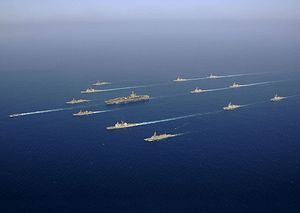The U.S. Navy has dispatched one of its carrier strike groups to the South China Sea amid rising tensions with China.
According to a press release by the U.S. Navy’s 7th Fleet, the John C. Stennis Strike Group is conducting routine operations in the South China Sea. The U.S. armada transited the Luzon Strait on March 1 and has been operating in the eastern half of the South China Sea for the past four days, the press statement reads.
The Nimitz-class nuclear-powered supercarrier, USS John C. Stennis, is accompanied by the Arleigh Burke-class Aegis destroyers USS Chung-Hoon, USS William P. Lawrence and USS Stockdale, as well as the Ticonderoga-class guided-missile cruiser USS Mobile Bay.
Another U.S. Navy ship, the Ticonderoga-class cruiser USS Antietam is conducting a separate routine patrol in the region. “The command ship Blue Ridge, the floating headquarters of the Japan-based 7th Fleet, is also in the area, en route to a port visit in the Philippines,” according to the Navy Times.
The 7th Fleet press release summarizes all U.S. naval activities in the South China Sea over the last few months:
In recent months, other U.S. Navy ships have conducted similar events in the 7th Fleet area of operations including the Arleigh Burke-class guided-missile destroyers USS Curtis Wilbur (DDG 54), USS Lassen (DDG 82), USS Preble (DDG 88) and USS McCampbell (DDG 85), the multi-purpose amphibious assault ship USS Essex (LHD 2), the amphibious dock landing ship USS Ashland (LSD 48), the Ticonderoga-class guided-missile cruiser USS Chancellorsville (CG 62), and the Freedom-class littoral combat ship USS Fort Worth (LCS 3).
While operating in the South China Sea, the U.S. carrier strike group has been shadowed by a number of People’s Liberation Army Navy (PLAN) vessels. “We have Chinese ships around us that we normally didn’t see in my past experience,” said Captain Greg Huffman, the commanding officer of the USS John C. Stennis. “Everything I have heard over bridge-to-bridge channels has been good communications between professional mariners,” he noted.
In a show of force, aircraft from the USS John C. Stennis have so far conducted 266 sorties in the South China Sea. However, the U.S. Navy has downplayed its activities in the contested waters. “Our ships and aircraft operate routinely throughout the Western Pacific — including the South China Sea — and have for decades,” according to a U.S. Pacific Fleet spokesman. “In 2015 alone, Pacific Fleet ships sailed about 700 combined days in the South China Sea.”
As I reported previously, the head of U.S. Pacific Command (PACOM), Admiral Harry Harris, said in a senate testimony in late February that “China is clearly militarizing the South China Sea and you’d have to believe in the flat Earth to think otherwise.”
“The accusation [that China is militarizing the region] can lead to a miscalculation of the situation,” said Fu Ying, a spokeswoman for China’s National People’s Congress, in response to the admiral’s remarks, according to The Navy Times. “If you take a look at the matter closely, it’s the U.S. sending the most advanced aircraft and military vessels to the South China Sea.”
The Diplomat‘s Ankit Panda and Prashanth Parameswaran discussed the arrival of the John C. Stennis carrier strike group in the South China Sea on the latest podcast episode.

































